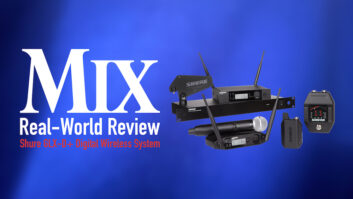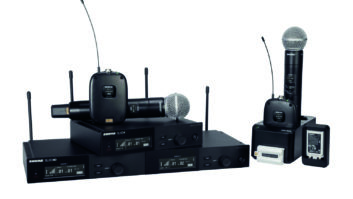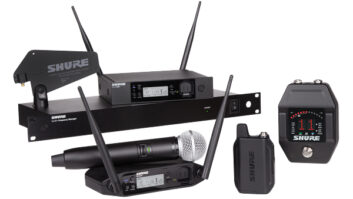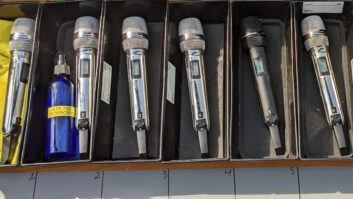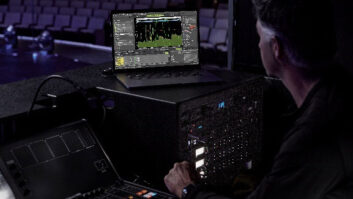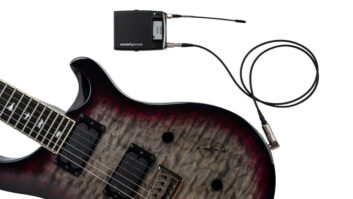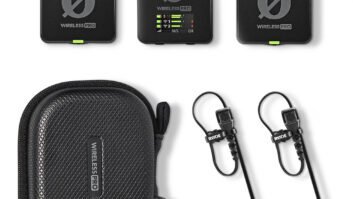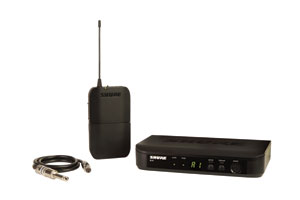
The BLX Wireless System from Shure was designed to provide a professional level of audio and RF performance at an entry-level cost. Comprising three receivers and two transmitters, the BLX System enables easy setup and offers a choice of bodypack or handheld wireless transmitters. BLX bodypacks may be used with either a ¼-inch instrument cable or a variety of lavalier, headset or clip-on microphones, while the handheld transmitter is available with a choice of capsules including the industry-standard Shure SM58 and Beta 58. Several different BLX receivers are available: the BLX4 (single-channel) and BLX88 (dual-channel) receivers are designed for tabletop operation, and the BLX4R may be rack-mounted. Mix received the BLX4, BLX2 handheld transmitter with a Beta 58 capsule, BLX1 bodypack transmitter and WA302 cable for connecting the BLX1 to a guitar or bass.
Control and Setup
Controls on the BLX4 receiver comprise a front panel power switch plus pushbuttons for group and channel tuning. A green ready LED glows when the receiver detects a transmitter operating on a matching RF channel, and a two-color audio LED indicates signal present (green) or overload (red). A two-digit display shows the frequency group and channel of operation. Audio output comes from two rear-panel jacks: an XLR for microphone level output and a ¼-inch TS for instrument level. These outputs are not adjustable. Power is supplied via line-lump power supply (included), and a small cable clamp on the rear panel can be used to secure the power cable and connector from accidental removal.
Similarly, the transmitters are designed for easy operation with few controls: on/off switches, group and channel pushbuttons, and LEDs to indicate RF group and channel. Although the transmitter and receiver LEDs show group letter and channel number, there is no indication of the actual broadcast frequency. The BLX1 bodypack transmitter features a locking TA4 audio input connector, a captive whip antenna and an audio gain control concealed underneath the battery compartment door. Both transmitters require two AA batteries for operation with an estimated life of 14 hours. Operating range is stated as 300 feet line-of-sight, and RF transmission power is 10 milliwatts. The BLX System operates in the UHF band across a wide range of channels. Depending on the geographic region and local RF activity, up to 12 compatible BLX Systems may be used simultaneously.

Setup was easy. The BLX4 receiver has the ability to perform an RF spectrum scan to detect a vacant frequency. Push and release the group button and the BLX4 will start the scan, then automatically set itself to an open frequency. You can also set the frequency manually by pushing and holding the group button to select the group, then doing the same to the channel button to select the frequency. Transmitter channel is set manually by using the group and channel buttons to scroll through options until they match those of the receiver. Our BLX components were the M15 versions, capable of operating in the frequency range between 662 and 686 MHz. Shure offers other options depending on geographic location. If you need to know the specific transmission frequency, you’ll need to consult the BLX’s Frequency Compatibility Chart, which indicates the exact frequency for a group/channel combination (for example Group A, Channel 3 = 663.700 MHz, etc.).
Gain for the BLX1 bodypack transmitter is set via internal gain control, which accommodated most of the instruments we tried with the system. One exception we encountered was an active bass with a very hot output; even with the gain control down all the way we still heard a slight bit of distortion. Backing off the instrument’s volume control a bit solved the problem. The BLX2 handheld transmitter does not feature a gain control, but there is the ability to “pad” the transmitter by -10 dB. This is accomplished by pressing and holding the channel button for approximately five seconds, after which a small dot appears at the lower-right corner of the LED window, indicating the pad has been switched on. This could come in handy if a singer with a very loud voice uses the transmitter, but we never needed it in our trials. One feature of the BLX2 that we really liked is that the transmitter settings and power switch can be locked to prevent accidents (i.e. the talent turns the power off). See the “Try This” sidebar for the procedure.
Out and About
We used the BLX System with the handheld microphone transmitter on a number of stages across the country where there was a fair amount of RF activity: a minimum of four wireless instrument systems, five wireless IEM systems, a few wireless mics and the typical assortment of production RF devices. While we wouldn’t call these situations RF nightmares, they were certainly busy enough. The BLX System had no trouble (a) scanning the spectrum to find an open frequency, and (b) maintaining high-quality RF performance without any dropouts, static or hash.
Perhaps more importantly, the microphone sounded like a wired Beta 58—and that’s a good thing. The BLX4 receiver easily interfaced with a variety of mixing consoles and set up in minutes. Its tabletop design does not include jacks for antenna (or, for that matter, any external antenna), so most of the time we just plopped it on top of a rack in monitor world. This will be a big strength for gigging musicians who need the ability to get up and running quickly. Although the transmitters feature a low-battery warning, there is no provision for monitoring battery life from the receiver.
Likewise, the BLX1 bodypack performed admirably, delivering stable and consistent RF performance. We were concerned that audio quality might suffer in the low-frequency range when using the BLX1 with a bass (as we have experienced with other wireless systems in a similar price range), but that was not the case. In fact, both transmitters provided clear, clean audio without evidence of background noise or transmission artifacts. We also noticed—or rather, did not notice—any audible effects of companding, no impression of reduced dynamic range, pumping or breathing. While we wouldn’t call the BLX1’s construction bulletproof, it should easily hold up to medium-duty use.
Recommended
Shure’s BLX Wireless System is a great choice for installed wireless applications such as house of worship, karaoke bars etc., and for gigging performers who handle their own gear. Some of the limitations of the BLX4 receiver are addressed by the BLX4R, which may be rack-mounted, includes provisions for remote and/or distributed antenna, features adjustable audio output level, and has a more comprehensive display panel. Regardless, the BLX Wireless System is easy to set up and easy to use, supports simultaneous use of multiple systems, is reasonably priced and provides excellent audio quality. And that’s the bottom line.
Steve La Cerra is a New York-based based live sound and recording engineer.
Try This
The Shure BLX 1 bodypack and BLX2 handheld transmitters can be locked to prevent unwanted channel changes or from being accidentally turned off during a performance. First, locate the group and channel adjustment buttons by opening the transmitter’s battery compartment cover. Hold down the group button and press the channel button for two seconds. The LED display will flash rapidly, and the power indicator will blink red. This indicates that all controls have been locked to prevent unwanted changes. To unlock the transmitter, repeat the process. The power indicator will flash green and the LED will blink rapidly, indicating that the transmitter is unlocked. Locking or unlocking the BLX4 receiver is done in a similar manner: press and hold the group and channel buttons simultaneously. The display will flash rapidly to indicate it has been locked.
Product Summary
COMPANY: Shure Incorporated
PRODUCT: BLX4
WEBSITE:www.shure.com
PRICE: BLX4 Receiver: $159; BLX2 Handheld Transmitter with Beta 58 capsule: $229; BLX1 Bodypack Transmitter: $139; WA302 TA4F to ¼-inch cable: $18.
PROS: Very good sound quality, easy to use, compact, affordable.
CONS: Transmitters and receivers do not indicate actual broadcast frequency. Not intended for heavy touring use.
